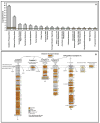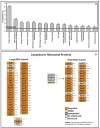Selective degradation of transcripts during meiotic maturation of mouse oocytes
- PMID: 17022963
- PMCID: PMC1847322
- DOI: 10.1016/j.ydbio.2006.09.008
Selective degradation of transcripts during meiotic maturation of mouse oocytes
Abstract
There is massive destruction of transcripts during the maturation of mouse oocytes. The objective of this project was to identify and characterize the transcripts that are degraded versus those that are stable during the transcriptionally silent germinal vesicle (GV)-stage to metaphase II (MII)-stage transition using a microarray approach. A system for oocyte transcript amplification using both internal and 3'-poly(A) priming was utilized to minimize the impact of complex variations in transcript polyadenylation prevalent during this transition. Transcripts were identified and quantified using the Affymetrix Mouse Genome 430 v2.0 GeneChip. The significantly changed and stable transcripts were analyzed using Ingenuity Pathways Analysis and GenMAPP/MAPPFinder to characterize the biological themes underlying global changes in oocyte transcripts during maturation. It was concluded that the destruction of transcripts during the GV to MII transition is a selective rather than promiscuous process in mouse oocytes. In general, transcripts involved in processes that are associated with meiotic arrest at the GV-stage and the progression of oocyte maturation, such as oxidative phosphorylation, energy production, and protein synthesis and metabolism, were dramatically degraded. In contrast, transcripts encoding participants in signaling pathways essential for maintaining the unique characteristics of the MII-arrested oocyte, such as those involved in protein kinase pathways, were the most prominent among the stable transcripts.
Figures





Similar articles
-
Global gene expression analysis during bovine oocyte in vitro maturation.Theriogenology. 2007 Sep 1;68 Suppl 1:S91-7. doi: 10.1016/j.theriogenology.2007.04.018. Epub 2007 May 18. Theriogenology. 2007. PMID: 17512044 Review.
-
A specific inhibitor of CDK1, RO-3306, reversibly arrests meiosis during in vitro maturation of porcine oocytes.Anim Reprod Sci. 2014 Jan 30;144(3-4):102-8. doi: 10.1016/j.anireprosci.2013.12.001. Epub 2013 Dec 12. Anim Reprod Sci. 2014. PMID: 24374180
-
Poly(A) RNA is reduced by half during bovine oocyte maturation but increases when meiotic arrest is maintained with CDK inhibitors.Biol Reprod. 2004 Aug;71(2):425-31. doi: 10.1095/biolreprod.103.026724. Epub 2004 Mar 31. Biol Reprod. 2004. PMID: 15056564
-
Maternal gene transcription in mouse oocytes: genes implicated in oocyte maturation and fertilization.J Reprod Dev. 2007 Apr;53(2):405-18. doi: 10.1262/jrd.18113. Epub 2006 Dec 20. J Reprod Dev. 2007. PMID: 17179655
-
Sculpting the Transcriptome During the Oocyte-to-Embryo Transition in Mouse.Curr Top Dev Biol. 2015;113:305-49. doi: 10.1016/bs.ctdb.2015.06.004. Epub 2015 Jul 29. Curr Top Dev Biol. 2015. PMID: 26358877 Review.
Cited by
-
Overview of Gene Expression Dynamics during Human Oogenesis/Folliculogenesis.Int J Mol Sci. 2023 Dec 19;25(1):33. doi: 10.3390/ijms25010033. Int J Mol Sci. 2023. PMID: 38203203 Free PMC article. Review.
-
Post-transcriptional gene regulation: from genome-wide studies to principles.Cell Mol Life Sci. 2008 Mar;65(5):798-813. doi: 10.1007/s00018-007-7447-6. Cell Mol Life Sci. 2008. PMID: 18043867 Free PMC article. Review.
-
NAT10 Maintains OGA mRNA Stability Through ac4C Modification in Regulating Oocyte Maturation.Front Endocrinol (Lausanne). 2022 Jul 22;13:907286. doi: 10.3389/fendo.2022.907286. eCollection 2022. Front Endocrinol (Lausanne). 2022. PMID: 35937804 Free PMC article.
-
The capacity of oocytes for DNA repair.Cell Mol Life Sci. 2018 Aug;75(15):2777-2792. doi: 10.1007/s00018-018-2833-9. Epub 2018 May 10. Cell Mol Life Sci. 2018. PMID: 29748894 Free PMC article. Review.
-
Localization of RNA and translation in the mammalian oocyte and embryo.PLoS One. 2018 Mar 12;13(3):e0192544. doi: 10.1371/journal.pone.0192544. eCollection 2018. PLoS One. 2018. PMID: 29529035 Free PMC article.
References
-
- Bachvarova R, De Leon V, Johnson A, Kaplan G, Paynton BV. Changes in total RNA, polyadenylated RNA, and actin mRNA during meiotic maturation of mouse oocytes. Dev Biol. 1985;108:325–31. - PubMed
-
- Bettegowda A, Patel OV, Ireland JJ, Smith GW. Quantitative analysis of messenger RNA abundance for ribosomal protein L-15, cyclophilin-A, phosphoglycerokinase, beta-glucuronidase, glyceraldehyde 3-phosphate dehydrogenase, beta-actin, and histone H2A during bovine oocyte maturation and early embryogenesis in vitro. Mol Reprod Dev. 2006;73:267–78. - PubMed
-
- BouniolBaly C, Hamraoui L, Guibert J, Beaujean N, Szollosi MS, Debey P. Differential transcriptional activity associated with chromatin configuration in fully grown mouse germinal vesicle oocytes. Biol Reprod. 1999;60:580–587. - PubMed
-
- Buratini J, Jr, Teixeira AB, Costa IB, Glapinski VF, Pinto MG, Giometti IC, Barros CM, Cao M, Nicola ES, Price CA. Expression of fibroblast growth factor-8 and regulation of cognate receptors, fibroblast growth factor receptor-3c and -4, in bovine antral follicles. Reproduction. 2005;130:343–50. - PubMed
Publication types
MeSH terms
Substances
Grants and funding
LinkOut - more resources
Full Text Sources
Other Literature Sources
Molecular Biology Databases

